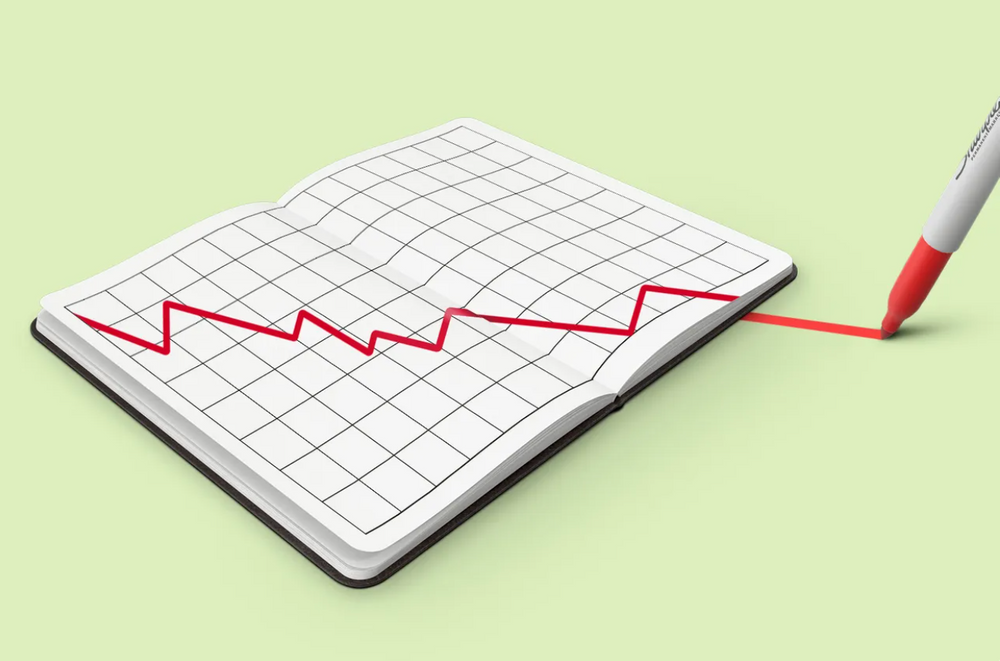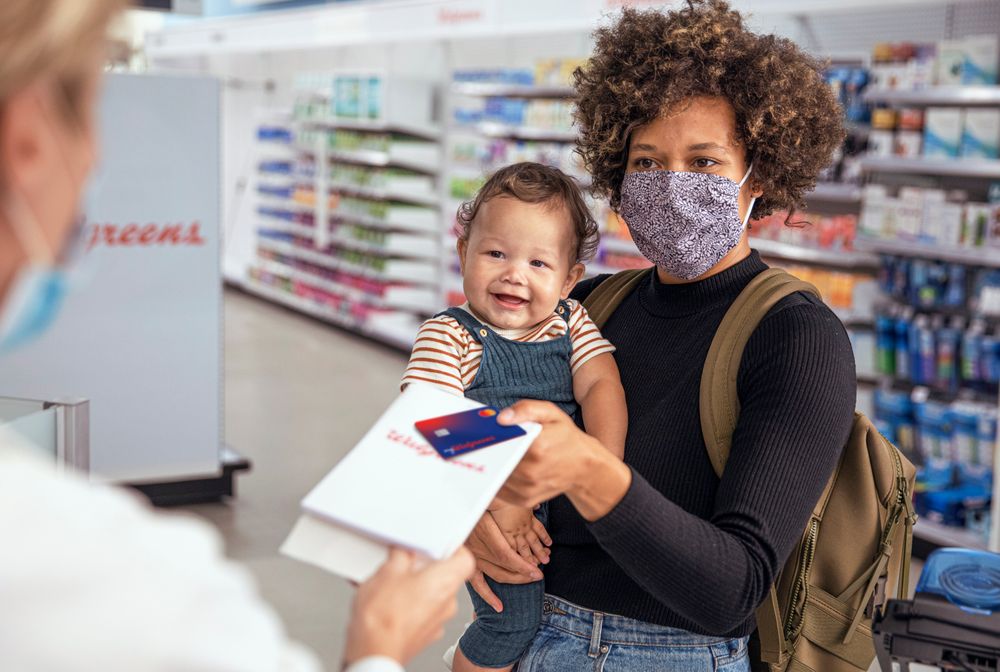|
Tomorrow, July’s retail sales numbers drop (more on that later). Let’s hope it’s not all doom and gloom.
In today’s edition:
- Coffee prices are way up
- Consumer confidence sinks
- Walgreens wants your loyalty
—Katishi Maake, Julia Gray
|
|
|
Giphy
|
The price you pay for coffee might not be spiking just yet, but the price roasters pay to get it in your cup is rising. With supply shortages due to extreme frost in Brazil, futures for arabica beans recently reached nearly $2.08 a pound, the highest price since 2014, and surged nearly 30% last month, almost doubling over the past year, per The Wall Street Journal.
Who’s at risk: Not coffee giants. The Starbuckses of the world will be fine for now (big surprise) because of hedged purchasing strategies, like buying beans in advance, according to Carlos Mera, coffee price expert and senior analyst at Rabobank.
“Large companies have much more financial muscle to up-front expenses and to adapt, to change locations,” Mera told Retail Brew. “That requires quite a bit of investment. [Smaller] coffee shops will be facing many more challenges, and labor shortages are a clear example.”
Take, for instance, Counter Culture Coffee, a Durham, NC, specialty coffee roasting company, which sources its beans from 50 supply streams across 18 countries, and supplies coffee to more than 1,000 restaurants, coffee shops, and boutique hotels across the nation.
Katie Carguilo, CCC’s coffee manager, said its retail partners have felt the strain of rising bean prices. “The main way we’ve seen this play out right now is that the base price expectations farmers have for selling coffee is increasing,” she told us. “When things impact our partners, it impacts our business.”
- Carguilo mentioned that some partners won’t be able to maintain their margins and pay these increased price points: “[They’ll] either go out of business or producers [won’t] want to sell us coffee because the price isn't competitive.”
Beyond the bean: Frost is far from the only thing threatening the coffee industry. Extreme weather conditions like heat waves and floods also affect agricultural markets, and these climate issues have created global supply chain issues for coffee growers, according to The WSJ.
“Our costs are increasing,” Carguilo said. “Transportation costs have skyrocketed, and the cost of finding and booking containers. Other costs of doing business are increasing, like packaging. Unless the business can absorb those costs, I think we'll see corrections happen on the sales side.”
The rising C market, or coffee commodity market, is causing internal prices in countries like Colombia and Peru to jump, Carguilo continued. “This means that in order to buy high quality coffees for our contracts, the associations and exporters we work with are having to raise the prices they pay to farmers and pass some of those costs on to us.”
- From March 2020 (when the C market was at $1.07) to now, Colombia’s internal coffee price has increased by 60%, according to Colombian coffee price lists provided by Carguilo.
“Our prices are not jumping 60%...but we are needing to make some adjustments now and moving forward, in order to pay competitively and secure the quality coffee we need.”
Even the big names will feel the burn eventually. “It takes time,” Mera added. “A large company might be hedged for one year, but after that, if coffee prices remain high, they'll need to pass it on to consumers.”
- The first place you might notice increased pricing is the lack of discounts, or buy-one-get-one offers, Mera said.
Some supermarket coffee producers are already raising prices. According to The WSJ, J.M. Smucker Co., the company behind Folgers and Dunkin’ ground coffee, said it’s “seeing inflationary costs impacting the entire fiscal year.” Nestlé, which makes Nescafé and Starbucks packaged coffee, is expecting supply chain costs to impact pricing during H2.
“The supermarket brands will have to pass on the increased costs of the coffee bean to the customer,” Mera explained. “The price of the coffee beans can be 50% of the total price.”
Carguilo questions whether companies’ prices will adjust to reflect bean price fluctuation in the future. “[Bigger players] would have a very good reason this year to raise the prices of their coffee because the market has gone up,” she said.
“But do those companies keep paying that same elevated price to producers year after year? If they raised their prices, I don't think they’d lower their prices a couple of years later [if] the prices that they pay to producers go back down.”—JG
|
|
|
Francis Scialabba
|
With Covid cases and inflation on the rise, consumer confidence is on the decline.
In the first half of August, US consumer sentiment dropped to 70.2 from 81.2 in July—its lowest level since 2011, according to the University of Michigan's index.
Last August, consumer sentiment was 74.1, making for a 5.3% YoY decline.
-
The 13.5% decline from the end of July is the third largest in the past 50 years.
“Consumers have correctly reasoned that the economy's performance will be diminished over the next several months,” survey director Richard Curtin said in a statement.
It’s not all doom and gloom, however. Overall sentiment is higher than in the midst of the pandemic, albeit slightly lower than in March 2020 before lockdown, according to the Forbes Advisor-Ipsos Consumer Confidence Tracker.
- “So far the Delta variant has certainly scared a lot of people but hasn’t necessarily caused a lot of people to withdraw from the economy,” Chris Jackson, SVP and head of polling at Ipsos, told Retail Brew. “We’re not seeing businesses shut down; we’re not seeing people stop going out altogether.”
Looking ahead: Tomorrow, July’s retail sales data goes live, and it’s earnings week, which should tell us a lot about how consumers actually feel. Things might not look too great, analysts say. Bank of America Global Research predicts sales will fall 2.3% from June, though Wall Street expects only a 0.2% decline.
“Even though the vaccinated are...the ones driving a lot of the uncertainty, they’re also the people who have the higher household income, generally speaking,” Jackson said. “It does still have the potential to have an impact depending on how the pandemic plays out.”—KM
|
|
|
|
In a commerce world leaning more toward the internet than toward brick and mortar, you’d think more brands would have worked to create a better online shopping experience, but most do the bare minimum.
Route is here to make sure you’re not making the same mistakes as everyone else.
Route helps you provide customers with a best-in-class end-to-end customer experience. And one of the sharpest tools in their toolbox is Visual TrackingTM.
Visual TrackingTM allows you to deliver a seamless, engaging, and on-brand tracking experience that cuts down on customers asking you where their order is—which saves you time and money (six bucks per WISMO request) and saves them a headache.
Plus, it’ll boost engagement and brand awareness. Wins all around!
Earn your customers’ loyalty by giving them the best experience possible. Try a demo with Route today.
|
|
|
Walgreens
|
Retailers know co-branded credit cards get customers in the door, so a handful are jumping on the bandwagon. Gap and IHOP recently announced new loyalty programs, and Walgreens is following suit.
Today the drugstore chain is rolling out two new credit cards for its 70+ million members, to reward pharmacy and grocery purchases and healthcare provider visits.
- Walgreens collaborated with Synchrony Bank, which claims the cards are the first of their kind in terms of rewarding personalized health and wellness choices.
Rewind: Walgreens revamped its customer loyalty program last year, introducing new perks like same-day retail pickup.
- “We're trying to expand and amplify what they’re earning, and co-branded credit cards and payment devices are a means to do that,” Maria Smith, VP of payments and financial services at Walgreens, told Retail Brew.
The big picture: Co-branded credit cards can drive loyalty in the online era, which is why providers are embracing third-party tech to digitize loyalty experience, per eMarketer. They’re also useful for selling e-commerce features like click and collect and digital wallets.
“Such offerings...can improve repeat engagement among shoppers and maintain or boost cards’ value for loyalists by giving them the retail experiences they demand—in turn making the programs more lucrative for retailers offering them,” according to eMarketer.—KM
|
|
-
Walmart will hire a director to lead the company’s cryptocurrency strategy.
-
Amazon will introduce its own food label to its online grocery operation.
-
Sweetgreen poached a former Starbucks tech exec, hoping to become the “Starbucks of salads.”
-
Aldi is hiring 20,000+ workers before the holiday season.
-
Restaurant menu prices are up 0.8%, the sharpest rise in 40 years.
|
|
|
|
Keep your brand loyalty goals on track. 98% of consumers say shipping affects brand loyalty, while 81% of shoppers say proactive shipping updates are critical to repurchasing—clearly, the post-purchase customer experience is just as important as any other shopping experience. So turn those numbers into an advantage with Route’s Visual TrackingTM, the tool which allows you to deliver a seamless, engaging, and on-brand tracking experience to keep your customers happy. Try a free demo with Route today.
|
|
|
New horizons: Fred Segal is undergoing a European expansion, and this is what CEO Jeff Lotman had to say about it. (Modern Retail)
Keep it clean: Steamery is at the forefront of an industry-wide effort to make clothes-cleaning trendy. (Business of Fashion)
Too cool: Quarantine made us all scream for ice cream, but indie shops are now in a make or break moment. (NYT)
|
|
|
At the mall, it’s where band tees are the only tees. In Retail Brew, it’s where we invite readers to weigh in on a trending retail topic.
Food delivery services became a mainstay during the pandemic, and the competition is heating up noticeably.
-
Gopuff recently acquired UK competitor Dija in an effort to expand to Europe.
- DoorDash orders hit a new high in Q2.
You tell us: Given the recent rise in Covid cases, what is your preferred dining method these days? Cast your vote here.
Last week, we asked about the best way to attract and retain workers. Almost two-thirds of you (65.1%) recommended higher wages, while 19.3% believe increased benefits is the way to go. Paying for education got only 6% of the vote.
|
|
|
It’s About to Get Personal
Tomorrow is a big day here in the Brewniverse. We’re launching Money Scoop, our new personal finance newsletter. Every Tuesday and Thursday, our writer/CPA (but like, the cool kind), Ryan Lasker, will discuss anything and everything you want to know about student loans, mortgages, portfolio management, retirement planning, and like a million other things. Make sure you’re subscribed so you don’t miss an issue. It could just be the most lucrative newsletter you ever read. Subscribe to Money Scoop before tomorrow’s first issue here.
|
|
|
Catch up on the Retail Brew stories you may have missed.
|
|
|
Written by
Julia Gray and Katishi Maake
Illustrations & graphics by
Francis Scialabba
Was this email forwarded to you? Sign up here.
|
ADVERTISE // CAREERS // SHOP // FAQ
Update your email preferences or unsubscribe here.
View our privacy policy here.
Copyright © 2021 Morning Brew. All rights reserved.
22 W 19th St, 8th Floor, New York, NY 10011
|
|









